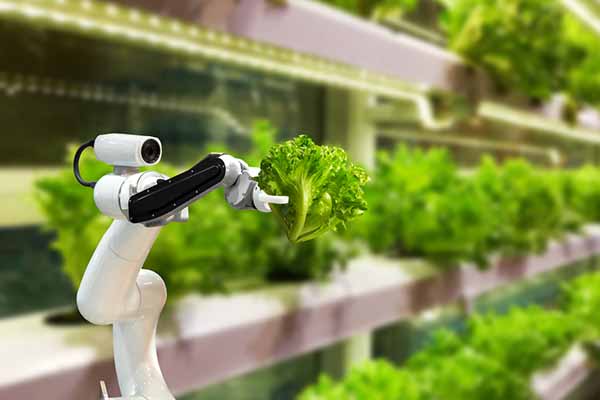For decades, Agriculture has been the economic backbone for India. The share of the agriculture sector in gross domestic product (GDP) reached almost 20 per cent during 2020-21 for the first time marking a brighter and visionary determination defining the next-age of agri-business in the country. Still today around a handsome 38% and above is into the agri-business. Though, persistent gap is emerging between supply and demand on the other hand, privatization is inviting newer business opportunities. Therefore, agriculture in India needs a major unconventional and technology-front revamp.
Today’s among the biggest challenge for the Indian Agriculture sector is logging productivity, efficiency, newer and quick ways of agriculture and infrastructure. Hence today farmers in India are adopting technology front cultivation processes defining their own scaling and better future. India currently has over 1300 agriculture startups – which are actively employing artificial intelligence (AI), machine learning (ML), internet of things (IoT), etc. – to increase efficiency and productivity in the sector. The COVID pandemic has now put them on an upwards growth trajectory. The states of Karnataka and Maharashtra and the Delhi National Capital Region (NCR) are major hubs for agri-startups in India, report India Briefing.
New Age of Agriculture in India
As the global population and their food habits vigorously amalgams; food security becomes a critical tussle. Today Food security is a top concern among global economies hence resulting to inflation. The global population is expected to reach 9.8 billion by 2050. Shortages of agri resources, distribution and access bottlenecks is straining the agriculture cash crops. Policymakers globally are increasingly looking for long-term solutions to leverage more and more technology in agricultural operations.
The Growth of Agri-Tech Business
The saviors for modern agriculture demand and revolutionizing this sector are now names as agri-techs. These agri-tech companies have been innovating and delivering modern solutions to traditional agricultural problems. Till 2020, reports state that agritech entrepreneurs valued at $26.1 billion in funding. Between 2020 and 2027, the global agritech industry is expected to develop at a compound annual growth rate (CAGR) of 12.1%. Like China and the United States, India as a competitor.
Giving the current scenario of agriculture in India, farms and farmland owners are finding agritech approaches as modern problem solvers. With agritech boom, agriculture sector, valued at US$370 billion and continues to be the primary source of income for almost 40% of the population and provides 19.9% of the national GDP (FY 2021). Though infrastructural problems still haunts the India agri sector and modern agritech companies are in a constant endeavor to address these challenges. To address these issues and increase farmer incomes, Indian agriculture requires technology-assisted modernisation backed by strong reforms – and this is where agritech is likely to play a key role.
Logistics and E-Commerce Frontiers
Indian yields from the farmers are becoming lowest in the world, hence resulting to meager incomes. During the first wave of the pandemic the penetration of digitalization and technology unrelieved new hope and potential to carry on their businesses. Real-time exchange of information, products delivery, information dosages with other products and more became critically important where newer forms of logistic and e-commerce services and companies helped the farmers business on-the-go. Empowering traders, intermediaries in the agri-output supply chain is the need of the hour and many agri-tech businesses are tapping these problems. Technology and its various newer forms and approaches are said to be the boon for the agriculture sector in India. Apart from the value chain and market access, high-value crops will create a fundamental change; in the agri-tech market. Tech, data, and digitisation will lead to an increase in the farmer’s income. It may be a slow process, but it will happen. Agri-tech will also help solve the problem of over-employment at the farm level.
Impact of COVID-19 Pandemic on Agritech Market
According to the latest situation report from the World Health Organization (WHO), the US, Spain, Italy, France, Germany, the UK, Russia, Turkey, Brazil, Iran, and China are some of the worst affected countries due to COVID-19 outbreak. The COVID-19 crisis is affecting the industries worldwide, and the global economy is anticipated to take the worst hit in the year 2020 and likely in 2021. The pandemic has disturbed agriculture businesses and suppliers around the globe. Fresh vegetables and fruit become increasingly scarce in various regions since the COVID-19 pandemic hampers the global movement of agritech market growth.
Investments in Sophisticated Agriculture Technologies
With the increase in effective connection between farmers owing to digitalization, the use of state-of-the-art technologies such as IoT and cloud would encourage farmers to adopt advanced agricultural ecosystem. Below mentioned are some of the features provided by agritech- Ag Biotechnology, agribusiness marketplaces, bioenergy & biomaterials, farm management software, sensing & IoT, farm robotics, mechanization & equipment, midstream technologies, and novel farming systems. Agricultural biotechnology, novel farming and farm management systems, and sensing and IoT products are a few prominent technologies attracting massive farm tech investments. Surge in the number of agritech startups and increasing penetration of sensor-based technologies are among the other factors leading to the rise in these tech investments, and thereby influencing the factor growth.
How Agritech Aids Productivity And Efficiency
Agritech primarily refers to an ecosystem of companies and startup enterprises that are capitalizing on technological advancements to deliver products or services for increasing yield, efficiency – both in terms of time and cost, and profitability for farmers across the agriculture value chain. The various segments within the agritech sector, which support the overall value chain are:
- Market linkage – farm inputs: Digital marketplace and physical infrastructure to link farmers to inputs.
- Biotech: Research on plant and animal life sciences and genomics.
- Farming as a service: Farm equipment for rent on a pay-per-use basis.
- Precision agriculture and farm management: Use of geospatial or weather data, IOT, sensors, robotics etc. to improve productivity; farm management solutions for resource and field management, etc.
- Farm mechanization and automation: Industrial automation using machinery, tools and robots in seeding, material handling, harvesting, etc.
- Farm infrastructure: Farming technologies, such as greenhouse systems, indoor-outdoor farming, drip irrigation, and environmental control, such as heating and ventilation, etc.
- Quality management and traceability: Post-harvest produce handling, quality check and analysis, produce monitoring, and traceability in storage and transportation.
- Supply chain tech and output market linkage: Digital platform and physical infrastructure to handle post-harvest supply chain and connect farm output with the customers.
- Financial services: Credit facilities for input procurement, equipment, etc. as well as insurance or reinsurance of crop.
- Advisory/ Content: Information platforms online platform for agronomic, pricing, market information.















